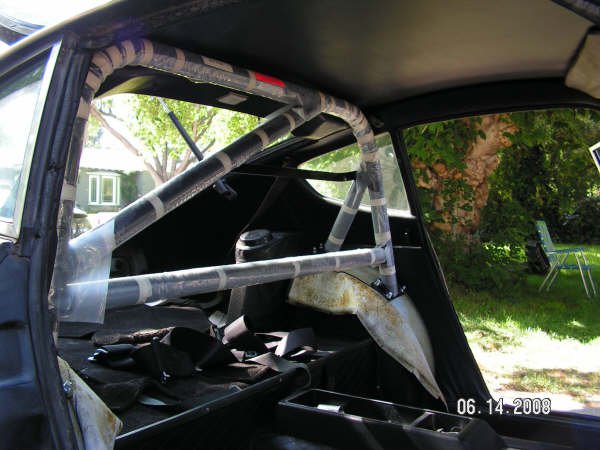-
Posts
629 -
Joined
-
Last visited
-
Days Won
2
Content Type
Profiles
Forums
Blogs
Events
Gallery
Downloads
Store
Everything posted by beermanpete
-
They slots are supposed to be different. See page EE-32 in the service manual. EE-32 Engine Electrical.pdf It might not help timing stability, but it is factory.
-
It looks the same as the distributor in our car. It seems to be that way from the factory.
-
Smaller main jets. Check the float levels. Check the fuel pressure. It should be between 5 and 7.5 PSI Check the power valves. They go bad easily on Holleys. Smaller main jets.
-

Not getting fuel :(
beermanpete replied to KillerZombie's topic in Trouble Shooting / General Engine
You need to perform the diagnostic procedures for the fuel system as specified in the factory service manual. The electric pump should be making some noise. If it is not, check for voltage at the terminals (when the key is on). If voltage is present the pump is bad. Go to http://www.xenons30.com/reference.html to get a copy of the service manual. -
We use Redline 75W90 GL-5 gear oil in our STi LSD. We have only driven the car at one track event so far but the LSD works well and there is no indication of a problem. This particular Reline oil contains the friction modifiers mentioned by John and Jon. Redline also sells the modifier separately which you can add to conventional 85W90 gear oil or the specialty gear oil of your choice. http://www.redlineoil.com/product.aspx?pid=133&pcid=4
-
Check the point gap. Also, check the condenser.
-
Yes, if the u-joints are staked in then it would be difficult to replace them. Our Z is a 73, as is the car the OP has. O'Reilly does not list a prop. shaft u-joint for the 280Z but they do for the 240Z. It depends on the year model in question it seems.
-

Rota Shakotans.... anyone running them?
beermanpete replied to ComicArtist's topic in Brakes, Wheels, Suspension and Chassis
225/50 will clear the original spring seat and the stock fender if the offset is correct. With coilovers there is more space due to the smaller diameter springs. This allows using even wider tires/wheels or a more negative offset(more backspace). Camber plates won't affect the clearance between the tire/wheel and the spring because they move together when making the camber adjustment. -
The U-joints are replaceable. The non-replaceable belief is a myth derived from Datsun saying so in the service manual. Replacement joints are available from the usual third party companies. They get installed the same way as any other typical u-joint.
-
The 240Z feels big compared to a Miata. Mostly due to the long hood I would say. The Z feels a little slower but may actually be about the same in acceleration. This is due to the Z having a broader torgue band. The Miata is peaky by comparison and peaky engines can feel fast but not actually be fast. As for handling, the Z is under-steer biased in stock form. The Miata is closer to neutral and mine seems to be over-steer biased. For me, the seating position in the Z is better. In the Miata I am always bumping my knees with the steering wheel or my hands while turning. I think the Z has the steering wheel a little further away from the pedals than the Miata.
-
The 5 bolts are likely the bolts holding the bearing cover on to the differential housing. All the R180s are like this. The early cars have "bolt-in" output shafts that use a long bolt through the center of the output shaft to hold the shaft in. These versions also have companion flange with 4 bolts that are used to attach the drive axel to the output shaft. The late 74 260Z (mid-year change I think) eleminated the companion flange, the 4 bolts, and the long bolt through the center of the output shaft. The output shaft directly holds the u-joint and snaps into the differential. The "snap-in" type have a spring clip near the end of the output shaft that interfaces with a groove in the side gears (inside the differential). I believe the splines are the same on both types but due to the difference in how they are attached to the differential they cannot (should not?) be interchaged.
-
Xnke, Sorry for the thread jacking. Since we are having a similar problem as you and we all seem to be stumped for the moment I thought it might help if I posted our activities here. We performed some diagnostics on out Z yesterday and the booster seems ok. It holds vacuum. When we started the car the brake pedal sinks a bit as the manifold vacuum is developed. When driving the car with and without the vacuum line connected we can detect a difference in pedal effort; lousy and worse. Our thoughts are now directed at the pressure differntial waring switch. In different, recent thread JohnC mentioned this part can cause a restricton if it gets into the "warning" mode. We have decided to remove to see if there is any improvement or change in the brake action. We will likely do this on Sunday. I will post the results.
-
Wouldn't this problem have valve clatter at the time of occurrance due to wide valve clearence while the HVA is not working correctly?
-
The motorcycle alternator is physically smaller and lighter so the pole piece (moving part) is smaller in diameter and lighter. This should reduce the inertial drag somewhat in the same manner that lightening the flywheel does. We are running it half the speed of the original alternator, further reducing drag. Since this alternator is from a 1987 motorcycle it is newer than the original alternator from the Zs and might have some newer design features that improve efficiency somewhat.
-
The Subaru STi R180 LSD is a true bolt-in upgrade. You buy the Subaru diff. and the necessary output shafts from Beta Motorsports. That is all you need. The original propeller shaft, drive axles, and mustache bar are re-used. It looks identical to the OE diff as well. We put one in our car. I works great.
-

260z booster vacum leak
beermanpete replied to David GArcia's topic in S30 Series - 240z, 260z, 280z
An air leak at the location you describe would be caused by a bad seal in the brake booster. You will need to rebuild your booster. -
Have you made any attempt to see if there is a signal in the trigger wire at the tach? You should be able to measure a voltage there when the engine is running. Or, assuming this won't damage the ignition, ground it to see if it kills the eninge. If you have a signal the tach is bad or you missed a wiring problem in the power circuit.
-
If you have already ruled out bleeding, leaks, and a bad master then look for a displaced reaction disc in the brake booster. It is a rubber disc about the size of 2 or 3 quarters stacked up. It can fall out when the master is off, causing symptoms like you described. Read this for details: http://forums.hybridz.org/index.php/topic/69706-reaction-disk-pictures-and-walkthrough/
-
The piston to cylinder clearance is typically larger than stock for modified engines, especially when using forged pistons. If you are building your engine using all OEM parts for normal use follow the factory specifications. If you are building a higher performance engine follow the guidelines from the piston supplier, the how-to book, or a trusted source such as the machine shop doing the work on your block and head.
-
If you have a turbo model your compression is about right. For a normally aspirated model you should be getting around 170 PSI. The service manual for your particular model will provide the correct PSI specification. The variation from cylinder to cylinder indicates a problem, but not necessarily rings. You should check the valve clearance as a tight valve will give a low compression reading as well as other poor run symptoms. A cylinder leakage test should be done. This will tell you whether the rings, valves, or something else is the cause of the low compression. If you have weak rings or valves you will not be able to set the fuel/air mixture reliably due to those problems affecting the plug color and other indicators of the mixture.
-

My 240Z on the cover of Modified Magazine
beermanpete replied to Blakt Out's topic in S30 Series - 240z, 260z, 280z
Awesome!! For some reason it made think of the Dr. hook song. "GOING TO SEE MY PICTURE ON THE COVER GONNA BUY FIVE COPIES FOR MY MOTHER GONNA SEE MY SMILING FACE ON THE COVER OF THE ROLLING STONE" -
The "brown crud" is rust. It looks like there was rust on the outside of spark plug (likely due to water puddling while cleaning the engine) before you removed it from the engine. The rust got on the tip and threads because you did not clean the area around the plugs prior to removal and you dragged the tip of the plug through the rust as you removed it. You are right about being lean. The right plug looks lean compared to the left plug. This is unrelated to the rust issue.
-
It sounds like the booster is bad. We have the same symptoms with our car. We had a bad proportioning valve, no rear brake pressure. Replace it with an adjustable type and now the rear brakes work but the pedal effort is very high and there is no feedback from the brakes. I can't tell when it locks a wheel unless the rear end tries to come around. I am going to open the booster and have a look in week or two and time permits. Your early rear brake lock-up is likely the proportioning valve. Depending on year, they are serviceable.
-
We installed a 4-point Autopower rollbar in our 73 240Z. It mount to the wheel wells. I think we bought it from MSA.

